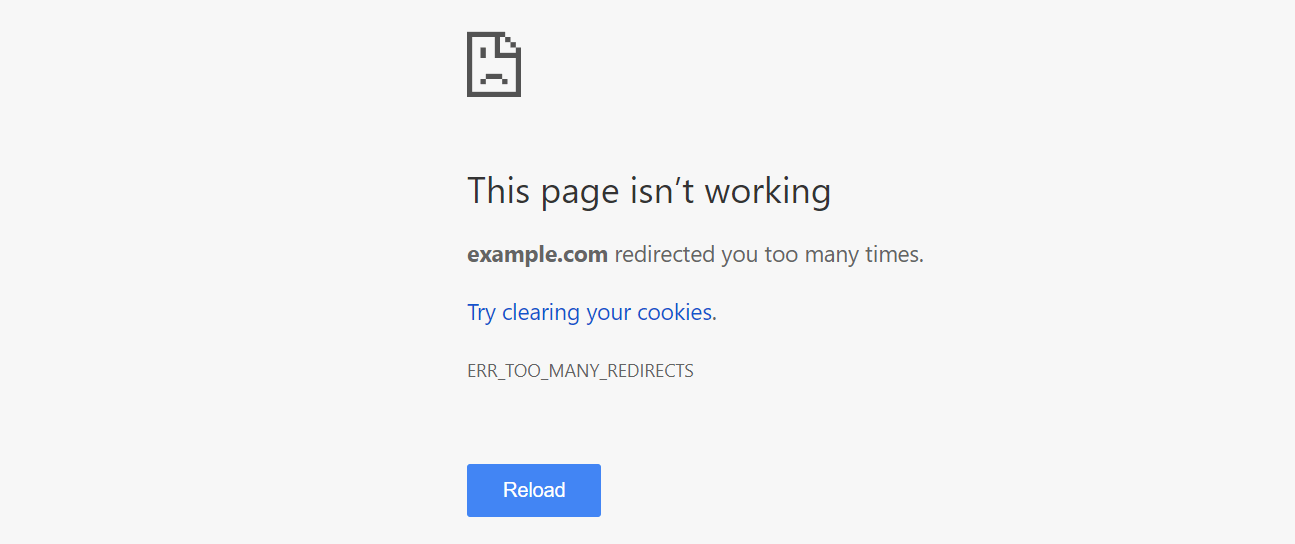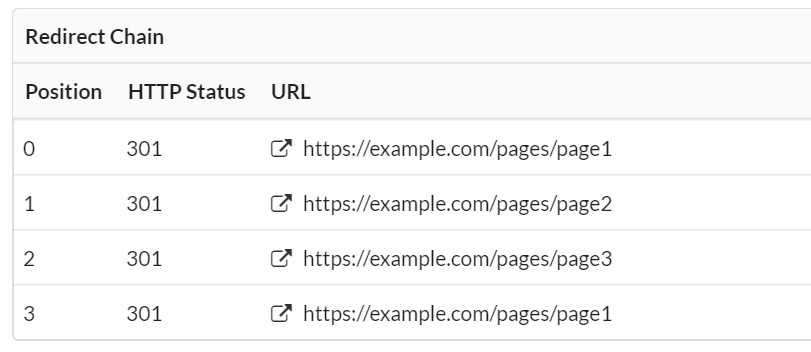Internal URL is part of a chained redirect loop
This means that the URL is question is part of a redirect chain which results in a redirect loop (e.g. URL 1 -> URL -> 2 -> URL 3 -> URL 1), which results in the page being inaccessible.
Why is this important?
A redirected URL, typically 301 (permanent) or 302 (temporary), means that the location of the page has changed, and the user is sent from the original URL to a new one. With a chained redirect loop, there are a number of URLs that each redirect in a chain, which eventually loops back around to the 'first' URL.
This is bad for SEO as search engine crawlers will be unable to access the page content to index it. It is also bad for users, who will be shown an error page (e.g. 'Website redirected you too many times').

What does the Hint check?
This Hint will trigger for any internal URL which is part of a chained redirect loop.
Examples that trigger this Hint:
Consider the URL: https://example.com/page1
The Hint would trigger for any URL if it returned a 3XX HTTP header response;
HTTP/... 301 Moved Permanently
...
Location: https://example.com/page2
...that is part of a redirect chain, so https://example.com/page2 also redirects;
HTTP/... 301 Moved Permanently
...
Location: https://example.com/page3
...and then https://example.com/page3 also redirects, back to the original URL:
HTTP/... 301 Moved Permanently
...
Location: https://example.com/page1
...How do you resolve this issue?
A redirect loop creates a dead-end for users and search engine crawlers alike, and needs to be resolved.
Chained redirects add a further complication, as multiple URLs are involved. As such, resolving such as problem requires a number of steps:
- Unpick the redirect chain, so you understand all the different redirecting URLs.
- If the pages should not be redirected in the first place, simply change the HTTP responses to 200.
- If, however, some of the pages should redirect, then the destination URL is incorrect. You will need to correct the destination URL, and identify all the incoming links so you can also point those as the destination URL.
You will need to resolve the issue for all URLs in the chain. Bear in mind that often, you will find URLs in the chain that actually have no incoming links themselves. For example if your looped chain looked something like this;
- https://example.com/page1 redirects to...
- http://example.com/page1 redirects to...
- http://www.example.com/page1 redirects to...
- https://example.com/page1
You may find that the http URLs are not actually linked to anywhere on the website, and only come about via these redirects (and perhaps a blanket rewrite rule) - so simply skipping these out of the chain could resolve the issue for those URLs.
How do you get more data from Sitebulb?
In order to unpick the redirect chain (#1 above), you will need to see all the URLs in the chain. You can do this by clicking the blue URL Details button from the URL List, and scrolling to the Redirect Chain section on the Overview.

You can also then view the Incoming Links, which will need to be updated to the destination URL (#3 from the solution above).

 Sitebulb Desktop
Sitebulb Desktop
Find, fix and communicate technical issues with easy visuals, in-depth insights, & prioritized recommendations across 300+ SEO issues.
- Ideal for SEO professionals, consultants & marketing agencies.
 Sitebulb Cloud
Sitebulb Cloud
Get all the capability of Sitebulb Desktop, accessible via your web browser. Crawl at scale without project, crawl credit, or machine limits.
- Perfect for collaboration, remote teams & extreme scale.